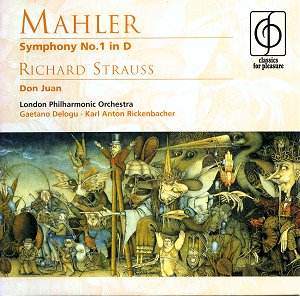 Composer: Gustav Mahler
Composer: Gustav Mahler
Works: Symphony No. 1 in D major; Richard Strauss – Don Juan, Op. 20
Performers: London Philharmonic Orchestra, cond. Gaetano Delogu (Mahler); London Philharmonic Orchestra, cond. Karl Anton Rickenbacher (Strauss)
Recording: 1-3 February 1976 at Fairfield Hall, Croydon, England (Mahler); 2-3 April 1985 at Walthamstow Assembly Hall, England (Strauss)
Label: Classics for Pleasure
The coupling of Mahler’s Symphony No. 1 and Strauss’s symphonic poem Don Juan on this recording offers a fascinating glimpse into the orchestral landscape of the late 19th century. Both pieces, composed in 1889, represent significant milestones in their respective composers’ careers. Mahler’s First Symphony, often regarded as his “Titan,” serves as an ambitious synthesis of symphonic form and programmatic intent, while Strauss’s Don Juan marks a decisive step towards the lush, expressive orchestral palette that would characterize his later works. The juxtaposition of these two works invites listeners to explore the contrasting aesthetic philosophies of Mahler and Strauss, both contemporaneous figures yet emblematic of divergent artistic trajectories.
The performance of Strauss’s Don Juan by the London Philharmonic Orchestra under Karl Anton Rickenbacher is a dazzling display of orchestral virtuosity. The recording captures the piece’s inherent dynamism and emotional intensity with remarkable clarity. Rickenbacher’s brisk tempo choices propel the music forward, creating an exhilarating experience that may surprise listeners accustomed to more measured interpretations. The orchestra responds with impressive precision and energy, particularly in the opening statements, where the brasses and strings intertwine to create the character of the eponymous hero. However, the decision to eschew the typical slowing down into the recapitulated horn theme may feel somewhat abrupt, potentially diminishing the emotional weight of this crucial moment. Nonetheless, the orchestral texture remains vibrant and full-bodied throughout, showcasing the brilliance of Strauss’s orchestration.
Conversely, Mahler’s First Symphony under Gaetano Delogu presents a different set of challenges. The performance, while competent and technically sound, lacks the depth of interpretative engagement that one might find in more acclaimed renditions, such as Leonard Bernstein’s interpretation with the Concertgebouw Orchestra. Delogu’s approach, though warm and inviting, often feels somewhat superficial, particularly in the opening movement where Mahler’s carefully crafted birdcalls and naturalistic themes risk becoming mere fragments rather than poignant musical statements. The lush string passages in the finale do evoke a degree of lyrical beauty, yet they rarely convey the profound yearning and existential angst intrinsic to Mahler’s vision. This lack of immersive engagement may leave listeners yearning for a more profound connection to the emotional subtext that Mahler so intricately weaves throughout his score.
The sound quality of this recording, a mix of analogue for Mahler and digital for Strauss, presents a commendable auditory experience. While the Strauss benefits from the clarity and detail of DDD technology, Mahler’s analogue sound, though slightly less defined, does manage to convey a warmth that is often characteristic of live orchestral performances. The sonic architecture allows for a discernible balance between sections, though the Mahler performance could have benefited from more pronounced dynamic contrasts to heighten the emotional stakes.
The pairing of these two works is intriguing, allowing listeners to reflect on the shared historical context of Mahler and Strauss while also highlighting their distinct approaches to orchestral writing. While Rickenbacher’s interpretation of Don Juan stands out as a compelling and energetic performance, Delogu’s Mahler, though not devoid of merit, ultimately lacks the depth and interpretative insight that one might hope for in such a competitive field. This recording thus serves as a valuable exploration of two seminal works from the fin-de-siècle repertoire, offering both rewards and limitations in equal measure.



